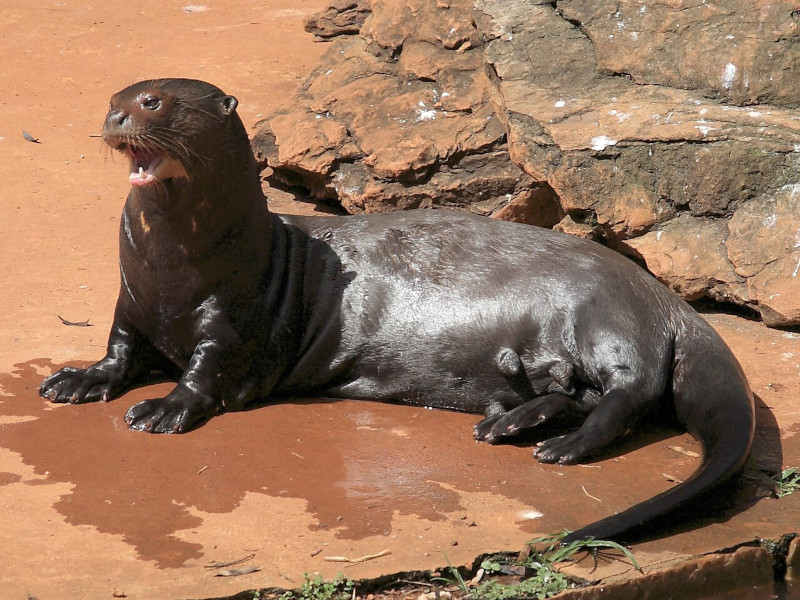
Giant Otter Facts
- This magnificent creation of evolution remains best known by the appropriate and descriptive term of the Giant Otter. It has only one other accepted english language title. That’s the similar name of Giant River Otter. It also has names in other tongues.
- Within the scientific community, however, the animal’s likely better known by its technical moniker. Unfortunately, like many such, it’s a nearly impossible one for the layperson to pronounce. That’s because it has the formal name Pteronura brasiliensis.
- The creature received that epithet due to the efforts of Johann Friedrich Gmelin. The noted German naturalist accomplished the first formal recognition of it as a separate and distinct species. This scientifically noteworthy deed occurred in the year 1788.
- No matter which of these designations one chooses to use, the mammal distinguishes itself in many ways. In terms of length, it’s presently the largest member of its Family. It’s also well known among experts as the most vocal of all known related species.
- Regrettably, though, the population of the remarkable Giant Otter appears to be diminishing. That unfortunate situation further seems to hold true throughout the entirety of its range. The IUCN therefore currently lists it as Endangered on its Red List.
- The animal faces a multitude of threats to its continued existence as a species. Poaching represents an ongoing problem, and has for many decades. In more recent times, however, new perils developed. These include habitat loss and climate change.
Related Articles
Giant Otter Physical Description
The fabulous Giant Otter immediately stands out from its numerous relatives. Purely physical attributes aren’t the only way in which this happens, of course. Nonetheless, the sheer size of this masterpeice of evolution qualifies as probably its most astounding aspect.
That’s true since, as the name itself implies, it’s a giant among its kind. Yet this also represents another manner in which it sets itself apart from other otters. Unlike most of them, it displays only the tiniest degree of the physiological trait of sexual dimorphism.
The small amount that the animal does manifest in this regard results in females attaining a marginally smaller size than males. Due to this fact, distinguishing the genders from a distance tends to be extremely difficult for all but the most highly trained observers.
Males reach an average body length measuring from 4.9 – 5.9 ft (1.5 – 1.8 m). Females, however, manage a mean measurement in this regard totalin 4.9 – 5.6 ft (1.5 – 1.7 m). The tail adds an additional average of 28 in (70 cm) to specimens of both genders equally.
Weights of mature examples of the aptly-named Giant Otter also vary between genders. Yet, in keeping with the similarity of length, this remains similar. The males average roughly 57 – 71 lb (26 – 32 kg). Females, though, typically mass between 49 – 57 lb (22 – 26 kg).
Its fur is also the shortest of any otter species. This generally presents as chocolate brown, but sometimes shows as reddish. Meanwhile, the muzzle develops as short, and the ears as small and rounded in shape, and the nose also small. It has short legs and webbed feet.
- Kingdom: Animalia
- Phylum: Chordata
- Class: Mammalia
- Order: Carnivora
- Family: Mustelidae
- Genus: Pteronura
- Species: P. brasiliensis
Giant Otter Distribution, Habitat, and Ecology
The impressive Giant Otter evolved as native to a moderate expanse of the globe. The precise location of that zone of habitation, however, comes as no surprise to most who learn of it. That’s because the creature developed as endemic to a portion of South America.
Originally, it inhabited a much greater section of the continent. Sadly, though, the mammal now lives in only roughly 20% of that original range. At present, it’s only known to live natively in a total of ten countries, including Brazil, Bolivia, Peru, and Venezuela.
Fortunately, though the Mustelid evolved decided preference regarding its habitat, it also shows adaptability in this respect. It therefore remains present in several types of similar ecosystems. Though technically amphibious, its primarily terrestrial in nature.
It principally appears in either freshwater streams or rivers. That especially includes one’s that flood on a seasonal basis. Yet it also resides in natural springs and permanent lakes. The animal also prefers the close proximity of marsh, swamp, forests, and meadows.
In keeping with the pattern of its kind, the Giant Otter also has a purely carnivorous diet. It mainly consumes quantities of locally available fish species. Yet, it occasionally augments this with such fare as frogs, prawns, snakes, and even various small reptiles!
The animal constructs large dens alongside bodies of water. Here, it typically lives in large social groups. These sometimes number up to 20 individuals, though 6-8 remains more typical. Much like many similar species, it’s also quite territorial in its behavioral patterns.
Speies Sharing Its Range
Check out out other articles on 3 Amazing North American Amphibians, Pesquet’s Parrot, Gobi Desert, Kinnikinnick, Australian Painted Lady, Axolotl, Mangrove Monitor, Knysna Seahorse
